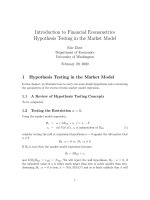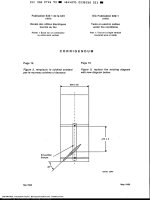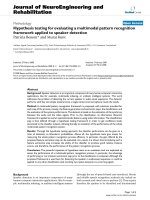Chap12: Hypothesis testing: Describing a single population
Bạn đang xem bản rút gọn của tài liệu. Xem và tải ngay bản đầy đủ của tài liệu tại đây (1.38 MB, 115 trang )
Chapter 12
Hypothesis testing:
Describing a single population
2
Introduction
The purpose of hypothesis testing is to
determine whether there is enough
statistical evidence in favour of a certain
belief about a parameter.
3
Introduction…
Examples
• In a criminal trial, a jury must decide whether
the defendant is innocent or guilty based on the
evidence presented at the court.
•
Is there statistical evidence in a random sample
of potential customers, that supports the
hypothesis that more than p% of potential
customers will purchase a new product?
•
Is a new drug effective in curing a certain
disease? A sample of patients is randomly
selected. Half of them are given the drug, and
the other half a placebo. The improvement in
the patients’ conditions is then measured and
compared.
4
A criminal trial is an example of hypothesis testing
without the statistics.
In a trial a jury must decide between two
hypotheses. The null hypothesis is
H
0
: The defendant is innocent.
The alternative hypothesis or research hypothesis is
H
A
: The defendant is guilty.
The jury does not know which hypothesis is true.
They must make a decision on the basis of evidence
presented.
5
12.1 Concepts of Hypothesis Testing
In the language of statistics convicting the
defendant is called
rejecting the null hypothesis in favor of the
alternative hypothesis.
That is, the jury is saying that there is enough
evidence to conclude that the defendant is
guilty (i.e., there is enough evidence to support
the alternative hypothesis).
Hypothesis Testing
6
If the jury acquits it is stating that
there is not enough evidence to support the
alternative hypothesis.
Notice that the jury is not saying that the defendant
is innocent, only that there is not enough evidence
to support the alternative hypothesis. That is why
we never say that we accept the null hypothesis.
Hypothesis Testing
7
There are two possible errors.
A Type I error occurs when we reject a true
null hypothesis. That is, a Type I error
occurs when the jury convicts an innocent
person.
A Type II error occurs when we don’t reject
a false null hypothesis. That occurs when a
guilty defendant is acquitted.
Hypothesis Testing
8
The probability of a Type I error is denoted
as
α
(Greek letter alpha). The probability of
a type II error is β (Greek letter beta).
The two probabilities are inversely related.
Decreasing one increases the other.
Hypothesis Testing
9
In our judicial system Type I errors are
regarded as more serious. We try to avoid
convicting innocent people. We are more
willing to acquit guilty people.
We arrange to make α small by requiring the
prosecution to prove its case and instructing
the jury to find the defendant guilty only if
there is ‘evidence beyond a reasonable doubt’.
Hypothesis Testing
10
The critical concepts are these:
1. There are two hypotheses, the null and
the alternative hypotheses.
2. The procedure begins with the
assumption that the null hypothesis is
true.
3. The goal is to determine whether there is
enough evidence to infer that the
alternative hypothesis is true.
Hypothesis Testing
11
Hypothesis Testing
4. There are two possible decisions:
Conclude that there is enough evidence to support
the alternative hypothesis.
Conclude that there is not enough evidence to
support the alternative hypothesis.
5. Two possible errors can be made.
Type I error: Reject a true null hypothesis.
Type II error: Do not reject a false null hypothesis.
P(Type I error) =
α
P(Type II error) = β
12
Concepts of Hypothesis Testing
There are two hypotheses. One is called the
null hypothesis and the other the alternative or
research hypothesis. The usual notation is:
H
0
: — the ‘null’ hypothesis
H
A
: — the ‘alternative’ or ‘research’
hypothesis
The null hypothesis (H
0
) will always state that
the parameter equals the value specified in the
alternative hypothesis (H
A
).
pronounced
H ‘nought’
13
Concepts of Hypothesis Testing…
Consider Example 12.1 (mean computer
assembly time) again. Rather than estimate
the mean assembly time, our supervisor
wants to know whether the mean is
different from 130 units. We can rephrase
this request into a test of the hypothesis:
H
0
: µ = 130
Thus, our research hypothesis becomes:
H
A
: µ ≠ 130
This is what we are
interested in
determining…
14
The testing procedure begins with the
assumption that the null hypothesis is true.
Thus, until we have further statistical
evidence, we will assume:
H
0
:
µ
= 130 (assumed to be TRUE)
Concepts of Hypothesis Testing…
15
The goal of the process is to determine
whether there is enough evidence to infer
that the alternative hypothesis is true.
That is, is there sufficient statistical
information to determine if this statement
is true?
H
A
: µ ≠ 130
This is what we are
interested in determining…
Concepts of Hypothesis Testing…
16
There are two possible decisions that can be made:
Conclude that there is enough evidence to support
the alternative hypothesis (also stated as: rejecting
the null hypothesis in favour of the alternative).
Conclude that there is not enough evidence to
support the alternative hypothesis (also stated as:
not rejecting the null hypothesis in favour of the
alternative).
NOTE: we do not say that we accept the null
hypothesis…
Concepts of Hypothesis Testing…
17
Once the null and alternative hypotheses are
stated, the next step is to randomly sample
the population and calculate a test statistic (in
this example, the sample mean).
If the test statistic’s value is inconsistent with
the null hypothesis we reject the null
hypothesis and infer that the alternative
hypothesis is true.
Concepts of Hypothesis Testing…
18
For example, if we’re trying to decide whether
the mean is not equal to 130, a large value of
X (say, 300) would provide enough evidence.
If X is close to 130 (say, 132) we could not
say that this provides a great deal of evidence
to infer that the population mean is different
from 130.
Concepts of Hypothesis Testing…
19
Two possible errors can be made in any test:
A Type I error occurs when we reject a true null
hypothesis and
A Type II error occurs when we don’t reject a
false null hypothesis.
There are probabilities associated with each type
of error:
P(Type I error) =
α
P(Type II error ) = β
α
is called the significance level.
Concepts of Hypothesis Testing…
20
Types of Errors
A Type I error occurs when we reject a true
null hypothesis (i.e. Reject H
0
when it is TRUE).
A Type II error occurs when we don’t reject a
false null hypothesis (i.e. Do NOT reject H
0
when it is FALSE).
H
0
T F
Reject
I
Reject
II
21
13.2 Testing the population mean
when the variance σ
2
is known
Example 1
The manager of a department store is thinking
about establishing a new billing system for the
store’s credit customers. She determines that the
new system will be cost-effective only if the
mean monthly account is more than $170. A
random sample of 400 monthly accounts is
drawn, for which the sample mean is $178. The
manager knows that the accounts are
approximately normally distributed with a
standard deviation of $65. Can the manager
conclude from this that the new system will be
cost-effective?
22
The system will be cost effective if the mean
account balance for all customers is greater than
$170.
We express this belief as our research
hypothesis, that is:
H
A
: µ > 170 (this is what we want to
determine)
Thus, our null hypothesis becomes:
H
0
: µ = 170 (this specifies a single value for
the parameter of interest)
IDENTIFY
Example 1…
23
What we want to show:
H
0
: µ = 170 (we’ll assume this is true)
H
A
: µ > 170
We know:
n = 400,
= 178, and
σ = 65
What to do next?!
IDENTIFY
Example 1…
24
To test our hypotheses, we can use two
different approaches:
The rejection region approach (typically used
when computing statistics manually), and
The p-value approach (which is generally used
with a computer and statistical software).
We will explore both in turn…
COMPUTE
Example 1…
25









